Slope Development | Geography Optional for UPSC PDF Download
| Table of contents |

|
| Slopes |

|
| Genetic Classification of slopes |

|
| Convex Slope |

|
| Cliff or Free Face |

|
| Rectilinear Slope |

|
| Concave slope |

|
| Frequently Asked Questions (FAQs) of Slope Development |

|
Slopes
- The study of slopes in the physical landscape has long fascinated geomorphologists, as they hold a central role in the study of landforms. Despite their importance, the study of slopes has been largely neglected and faces numerous challenges.
- One of the main difficulties in studying slopes is determining their nature, the rate at which processes operate, and the impact of these processes on the slope. Additionally, it is difficult to trace the entire development of a slope and its changes in form over time.
- In landform studies, there are two main aspects that are typically focused on: form and process. "Form" refers to the morphology of a given region at a given time, while "process" refers to the operation of various agents that cause changes in the physical environment, such as soil creep, surface wash, and weathering.
- To better understand slope development, researchers have followed two main approaches: the historical approach and the process-form approach.
- The historical approach emphasizes the evolution of slopes from their origin to their present form. However, this approach suffers from the problem of accurately reconstructing past forms of the slope, as there is no standard method for verifying the accuracy of these reconstructions. It is also challenging to determine the age of a slope, as there is no universally applicable method for doing so.
- One commonly-held assumption among some researchers is that present-day slopes developed from near-vertical cliffs that weathered and modified over time. However, this assumption may not hold true in many cases, as slopes often border river valleys that were never vertical cliffs. Furthermore, river erosion does not always produce steep, vertical walls, as other processes like weathering and creep can also modify slope edges.
- As a result, the concept of an "initial slope" may be unrealistic. Determining the age of a slope based on its form is not an easy task, and even extensive field surveys cannot provide completely satisfactory results.
The Process-form Approach
- The Process-form Approach is based on the idea that the shape and steepness of a slope are determined by the interplay of weathering, erosion, transportation, and deposition. These denudation processes work in various combinations and at different rates, leading to a wide array of slope forms with varying degrees of steepness. Factors such as rock types, climate, and vegetation directly influence the types of slope forms that are produced.
- For instance, in a limestone region with sufficient rainfall, convex slopes are commonly found because rainwash is less effective due to the porous nature of the rock. In other regions, this might result in concave slopes. However, this approach, like the historical approach, faces several challenges. It is difficult to observe the various processes at work on slopes since weathering, creep, and rainwash occur very slowly and are not easily perceptible.
- To accurately study these processes, advanced tools and precise methods are needed for recording their operation. Moreover, it is hard to definitively establish that slope processes directly determine the form of the denudational slope. Another issue with the process-form approach is the possibility that many current slopes are not a result of present-day processes (Small, 1978). The relationship between slope form and climate has also been a subject of debate.
- If the slope is solely controlled by slope processes, it is assumed that different slope forms would be found in different regions. Some geomorphologists have emphasized this relationship, providing various examples to support their claims. However, the assumption that a specific type of slope will only form in a particular climate is not always accurate. For example, it was once believed that pediments are exclusive to desert regions, but now many scientists and geomorphologists agree that they can occur anywhere in the world.
Genetic Classification of slopes
Slopes are formed through two primary processes: Endogenetic and Exogenetic. Based on these processes, slopes can be broadly categorized into Endogenetic Slopes and Exogenetic Slopes.Endogenetic Slopes
- These slopes are formed as a result of processes occurring within the Earth's interior. Various geological movements, such as folding, faulting, and rift valley formation, contribute to the development of these slopes. They are also commonly referred to as tectonic slopes. Fault scarps are often found in association with faults and rift valleys.
- Volcanic eruptions, which are also a consequence of endogenetic processes happening within the Earth, create new landforms. These eruptions lead to the accumulation of lava and pyroclastic materials, forming various volcanic hills, plateaus, and cones.
- The landforms created by volcanic eruptions or tectonic activities are further modified by subaerial processes, resulting in the development of diverse slope forms.
Exogenetic slopes
- Slopes are formed as a result of external processes that take place at or near the Earth's surface. Factors such as weathering, mass wasting, erosion, and deposition play a crucial role in shaping landscapes. These processes constantly act on the surface, creating and modifying slope forms over time.
- We can classify slopes created by exogenetic processes into two main categories: (a) erosional or degradational slopes and (b) depositional or aggradational slopes.
- Erosional slopes are created by various forces, including wind, running water, waves, and glaciers. For example, glaciers and running water generate numerous landforms within their valleys. Escarpments, watersheds, river terraces, and coastal cliffs are all examples of slopes formed through erosion.
- On the other hand, depositional slopes are formed by the same agents but through the accumulation of material. For instance, running water creates alluvial fans and natural levees, glaciers form moraines, and wind results in sand dunes of various shapes and sizes. Additionally, deposition along coastlines leads to the formation of sandbars, barriers, and beaches. These are all examples of depositional slopes created by the actions of water, wind, and glaciers.
Slope elements
- Slope elements refer to the various forms or shapes that make up a slope's profile. These forms typically include convex (crest), rectilinear, and concave slopes. Convex slopes are usually found at the top of a hill, while concave slopes are located at the base.
- L.C. King and A.Wood believed that a standard composite slope profile consists of four main elements. The first, at the top, is the convex slope or crest. Below the crest, there is a scarp or free face, followed by a rectilinear slope. Finally, at the bottom, there is a concave slope. This is the most common composite slope profile; however, in reality, these elements can be found in various combinations, and not all of them may be present in a single slope profile.
- The combination of these elements in a slope profile depends on factors such as the rock's structure, the rock's nature, and the processes that operate on the surface. Below, we will discuss each of the four main types of slope elements (forms) in greater detail.
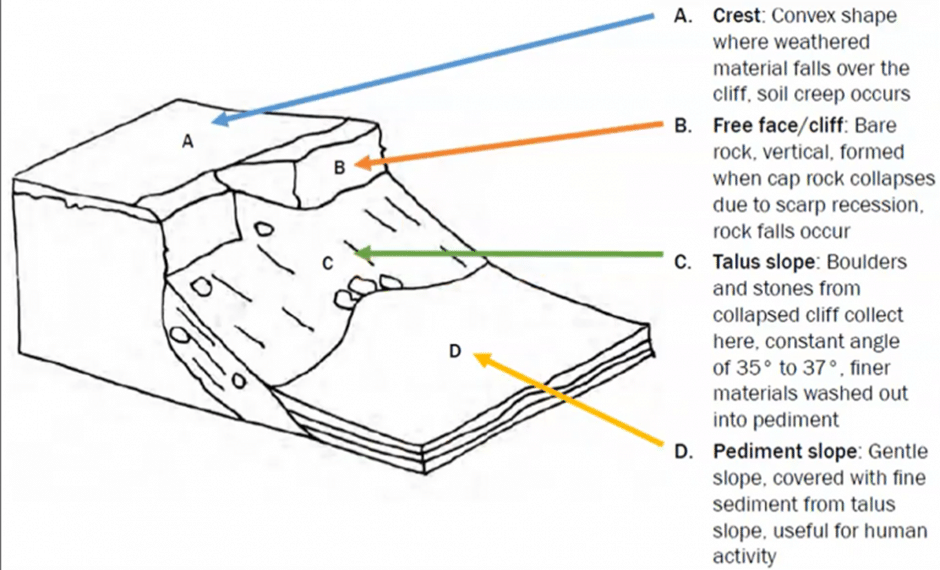
Convex Slope
- A convex slope is a type of slope that can sometimes cover an entire hillside, but it is most frequently found in the upper portions of a slope. This convex shape is created by the gradual wearing away of the landscape, known as the denudation process, and is typically found in humid, temperate regions.
- In the higher areas of a hill, a convex slope is often called a "crest" or "summit slope." As you move down the slope from the crest, the angle of the slope becomes steeper. The formation of this convex shape at the summit is primarily attributed to weathering and soil creep, which are the most active processes in creating this unique topography.
- This type of slope is also known as a "waxing slope," a term coined and popularized by the renowned German geomorphologist W. Penck. The term "summital convexity" is often used to describe a waxing slope, as it highlights the distinct curved shape of the slope's upper portion.
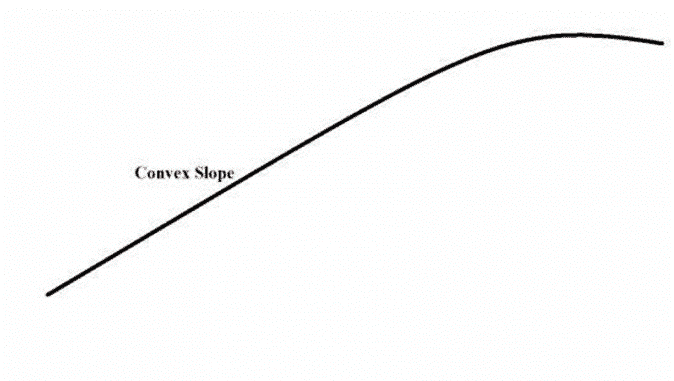
Cliff or Free Face
- A cliff, also known as a scarp or free face, is a steep, wall-like slope often found in various landscapes. Due to its steepness, cliffs are typically bare, as regolith or debris cannot accumulate on such a slope. Instead, any material that falls or erodes from the cliff settles at the base of the slope, creating a pile of debris.
- The term "free face" is used by many geomorphologists to describe a cliff, as it remains free from any detritus or debris. Cliffs can form along coastlines, where sea waves cause undercutting, in river valleys, glacial regions, faulted landscapes, and in various other locations. When weathered material falls or slides from the cliff, it accumulates at the base, forming a depositional feature known as a talus slope.
- Over time, the talus slope will continue to grow in size as more weathered material accumulates, eventually covering the lower portions of the free face and protecting it from further weathering. As the talus slope rises, the length of the free face diminishes, and the entire cliff may eventually disappear, replaced by an aggradational slope with a lesser angle than the original cliff.
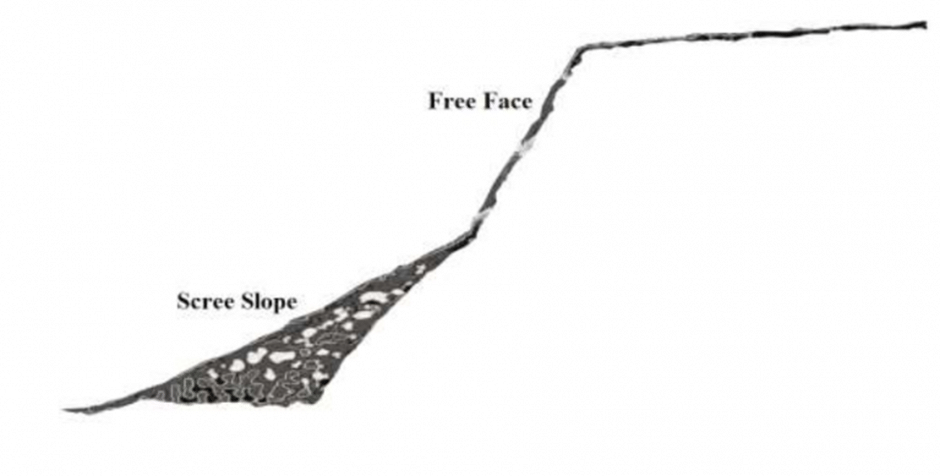
Rectilinear Slope
- Rectilinear slopes are a type of slope that is primarily found below cliffs or free faces, and are characterized by their straight profile and relatively constant slope angle. These slopes can vary in size and may sometimes dominate an entire slope area. They often extend from the summit of a hill or mountain down to the bottom of a valley.
- In many cases, rectilinear slopes are situated in the middle of a slope profile, with a broader convex section above and a larger concave section below. Some geomorphologists believe that these slopes are formed only through the process of aggradation, which is the accumulation of sediment or other material. However, this is not always the case.
- As noted by Small (1978), rectilinear slopes can also be a result of denudation, which is the wearing away of the Earth's surface by natural processes like weathering and erosion. In these instances, the slope is underlain by solid rock and may be covered by a thin layer of debris that is slowly moving downhill due to factors like frost and other natural forces.
- Rectilinear slopes are sometimes referred to as debris-controlled slopes, as the presence of debris can play a significant role in their formation and appearance. Additionally, Strahler (1950) used the term "repose slope" to describe these slopes, highlighting their unique characteristics and distinguishing them from other types of slope formations.
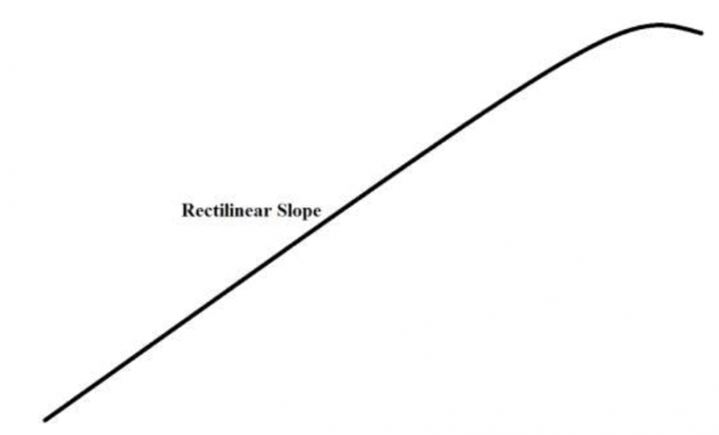
Concave slope
- A concave slope is found at the lowest part of a hill's slope profile, typically extending from the bottom of the hill down to the river valley. This area is often covered with debris, such as accumulated scree, which is spread across the slope due to rainwash. As a result, finer particles are dispersed further than coarser ones, leading to the formation of a concave shape.
- The term "waning slope" was coined by Penck to describe such slopes, which can display different characteristics depending on the climate. In arid and semi-arid regions, concave slopes often show a sharp break in gradient between the lower concave section and the steeper slopes above. However, in humid conditions, the concave base transitions more smoothly into the higher slopes.

The above-discussed elements are assumed to be present in a standard hill slope but as has been pointed out by many geomorphologists and thinkers that all four elements may not be noticed in a hill slope. One or more than one element may be missing from the slope profile owing to various reasons.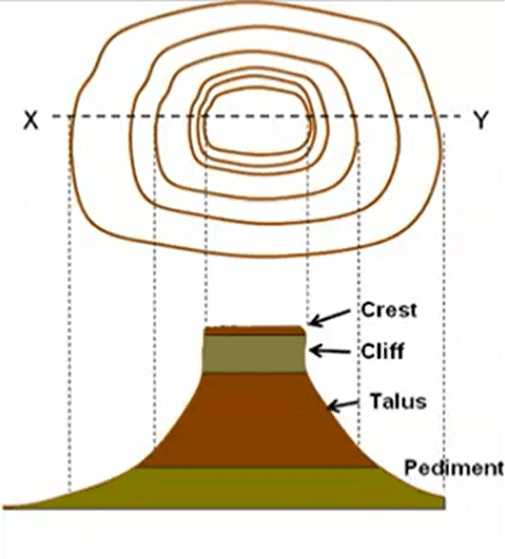
A slope profile can consist of various combinations of elements, and while there may be an infinite number of possible combinations, some are more common than others. Three frequently occurring composite slope combinations are discussed below:
- The convexo-rectilinear-concave slope profile features an upper convex portion, a middle rectilinear section, and a lower concave part. These three slope elements blend seamlessly, resulting in a curved slope profile (Small, 1978). This type of slope profile is often found in regions with weaker rock types, such as lowland England. The lengths of the different slope elements can vary, creating diverse landscapes. However, in areas with a wide variety of rock types, where hard and soft rocks alternate, or where the region has experienced multiple rejuvenations, the slope profile can become more complex.
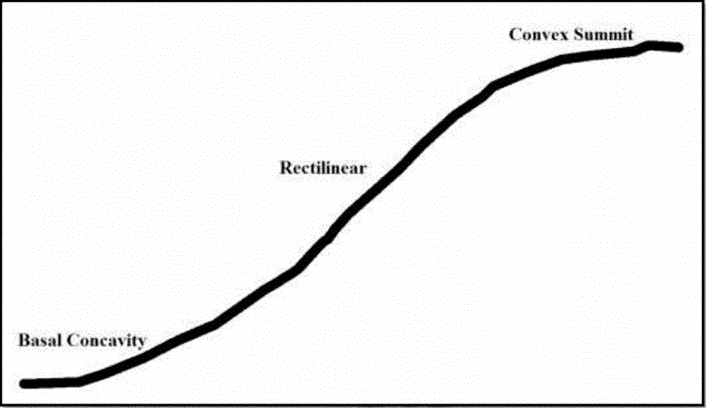
- In regions where there are alternating layers of massive and weak strata, high relief, deep valleys, and active weathering, a distinct composite profile can be observed. This profile consists of several free faces and rectilinear slopes, with minimal or no summital convexity and basal concavity (Small, 1978). Massive strata contribute to the formation of free faces, while weak and thinly bedded rocks result in rectilinear slopes.
- In arid regions with hard crystalline rocks, a composite slope profile is formed, which includes an upper section with a free face at a slope of 40° or more, a mid-section with a boulder-controlled slope at an angle of 25° or more, and a lower section with a gentle concave (pediment) slope at angles below 7 degrees.
- Various theories have been proposed by geomorphologists to explain the development of specific slope elements in a slope profile. Earlier attempts focused on linking certain processes to specific slope forms, such as rainwash and soil creep in the formation of convex and concave slope forms.
- American physiographer N. M. Fenneman suggested that the most common convexo-concave profiles are due to the action of running water. According to Fenneman, the upper slopes have less runoff during rainfall, with water moving as a thin sheet. As the water travels downslope, it collects particles and gains volume from additional run-off from higher up the slope. This leads to increased erosion in the sections of the slope further from the summit, resulting in convexity over time.
- Fenneman also argued that as the water reaches the lower part of the slope, the increased volume causes it to become concentrated in small channels, leading to the formation of gullies and ultimately a concave curve. However, many geomorphologists criticized Fenneman's hypothesis for not considering the role of soil creep in slope formation. Despite this, his ideas were supported by Horton (1945), who argued that erosion by sheet wash becomes more significant downslope due to increased run-off.
- Gilbert (1909) attributed soil creep as a major factor in the rounding of hilltop summits and the development of summital convexity, but his ideas were considered simplistic. Lawson, on the other hand, argued that rainwash was an important process on the upper slope, although he disagreed with Fenneman, suggesting that wash was most effective at the sloping summit.
- Many other scientists and geomorphologists have considered soil creep and rainwash as crucial processes in determining slope form, each proposing their own theories based on their understanding. However, it is important to note that, in addition to soil creep and rainwash, there are numerous other factors at play, and their interactions can be quite complex.
Conclusion
The study of slopes and their development is a complex field in geomorphology, with various factors and processes contributing to their formation. Two main approaches, the historical approach and the process-form approach, have been used to understand slope development. Slopes are classified into endogenetic and exogenetic types based on their formation processes, and their profiles consist of various combinations of convex, cliff or free face, rectilinear, and concave slope elements. The interplay of factors such as rock types, climate, and vegetation, as well as processes like weathering, erosion, and deposition, contribute to the diverse forms of slopes observed in nature. While progress has been made in understanding these processes, there is still much to learn about the intricacies of slope development and the interactions between various factors and processes.Frequently Asked Questions (FAQs) of Slope Development
What are the main challenges in studying slopes in the physical landscape?
The main challenges in studying slopes include determining their nature, the rate at which processes operate, the impact of these processes on the slope, and tracing the entire development of a slope and its changes in form over time.
What are the two main approaches to studying slope development?
The two main approaches to studying slope development are the historical approach, which emphasizes the evolution of slopes from their origin to their present form, and the process-form approach, which focuses on the interplay of weathering, erosion, transportation, and deposition in determining the shape and steepness of a slope.
What are the two primary categories of slopes based on their formation processes?
Slopes can be broadly categorized into Endogenetic Slopes, which are formed as a result of processes occurring within the Earth's interior, and Exogenetic Slopes, which are formed as a result of external processes that take place at or near the Earth's surface.
What are the four main types of slope elements (forms)?
The four main types of slope elements are convex slope, cliff or free face, rectilinear slope, and concave slope. These elements can be found in various combinations in a slope profile, and not all of them may be present in a single slope profile.
How do soil creep and rainwash contribute to the formation of slope forms?
Soil creep, which is the slow, continuous movement of soil and debris down a slope, contributes to the rounding of hilltop summits and the development of summital convexity. Rainwash, on the other hand, is the washing away of soil and debris by rainfall, and can contribute to the formation of both convex and concave slope forms depending on the location and intensity of the runoff.
|
303 videos|636 docs|252 tests
|
FAQs on Slope Development - Geography Optional for UPSC
| 1. What is the genetic classification of slopes? |  |
| 2. How are convex slopes formed? |  |
| 3. What are cliff or free face slopes? |  |
| 4. How are rectilinear slopes formed? |  |
| 5. What are concave slopes? |  |




















